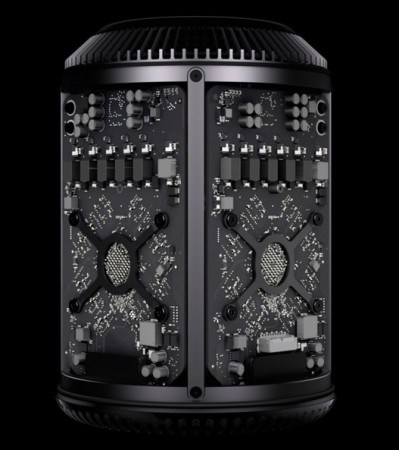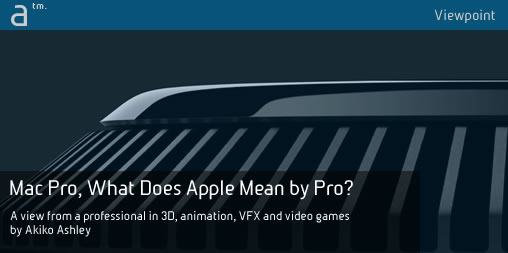When Apple finally announced the Mac Pro in all its details late in 2013–with a peek at the external enclosure box–a roar of applause from Mac professional users could be heard across the Internet. The beautiful design of the cylindrical shape with a tiny imprint blew a lot of Mac fans away. Technical magazines looked at the projected specs questioning the limited internal upgrade path within the box, and the proprietary design requiring manufacturers to customize their third party hardware for this box.

01 – Apple’s new Mac Pro 2013 sports dual AMD FirePro GPUs, the most notable new change in this latest generation Mac Pro beyond its radical redesign.
We live in a world where the market is driven by mass production. Proprietary tech can set up red flags to an IT person buying for a pipeline that has to be both backward and forward compatible. The Mac Pro is definitely a step up from the last generation Mac Pro. First glances at the specs are very impressive. This Mac Pro has a lot of hardware features that will suit a wide variety of professionals especially 2D Graphics Artists, Web Designers, CAD, Architects, and some film professionals.
The Key Specs on the new Mac Pro
- Next generation Xeon Processor (Xeon E5)
- Available in 4, 6, 8, or 12 cores on a single die
- 30 MB L3 Cache
- 40 GB/s PCI Express Generation 3 bandwidth
- 256-bit wide floating point instructions
- Four-channel DDR3 memory controller running at 1866 MHz
- Up to 64 GB of ECC memory
- AMD FirePro workstation-class GPU — it features two of them (2 GB, 3 GB or 6 GB of dedicated VRAM) D300, D500 or D700
- Up to 1 TB of Flash Storage
- Unified Thermal Core Design
- Built-in Thunderbolt 2 — with 6 Thunderbolt 2 ports
- 4 USB 3 Ports
- Two Gigabit Ethernet ports
- HDMI 1.4 ports
- 802.11 ac WiFi wireless networking, IEEE 802.11 a/b/g/n compatible
- Bluetooth 4 wireless technology
- Connect up to three (3) 4 K displays or 6 Thunderbolt Displays
- Supports the latest version of OpenCL
Real World Application
The point of this article is not about specs but real world application in the Professional world and what Apple’s definition of Pro is?
I ask this question because I work in the visual effects and animation industry–where technology is pushed to its maximum effectiveness. It is said that the two main industries that push technology to its edge are the military and the motion picture industry. This new Mac Pro is a true ‘Power House’ that can perform a lot of “compute intensive” tasks. It is twice as fast as the previous generation. It is quieter, has a lot more GPU power and with support for OpenCL 1.2 it provides an excellent speed bump for real time rendering.
This new machine is perfect for certain applications. ArchiCAD, Photoshop, and Unity users will love this machine. Everything you need is built inside with the one noticeable challenge–the upgrade path. While this machine is certainly great for tasks for some professionals, I am not sure it is made for all professionals. Those of us who depend on CUDA and the Kepler Quadro card family will find this a very difficult decision.
So? What is Apple’s definition of Pro?
Adobe showed off several of their software packages using OpenCL acceleration at SIGGRAPH 2013 last summer. It was superb when you consider that some effects in Adobe After Effects (AE) have been difficult to do in real-time. You could see very notable speed improvements from 25 percent on up. If you work as a graphics professional the new hardware combined with OpenCL 1.2 support in Mavericks would give you a great solution. Real-time editing with effects is a reality.
The reason someone in my field of 3D animation and visual effects would question if the definition of Pro includes such professionals who work in 3D is the lack of support for key hardware and software for our profession. You have to remember that high-end 3D professionals who use high-end workstations with 24 cores may not find the benefit of this new configuration by Apple. If you go to the Boxx website, you have the ability to custom configure your workstation, the same applies with HP. This is why companies like HP become involved in pipelines with studios like Dreamworks, for example, to benefit from the experience so they can design machines that are effective in the animation industry. Apple has for many years compared their Mac Pros with Consumer High End PC’s in their benchmark tests but never with a top of the line workstation made by Boxx Technologies, HP or Lenovo (formerly IBM tech).
Proprietary Design Can Get You Isolated
My other issue is the upgrade path. Apple has never been very lucky with “proprietary technology,” how many devices do you know even use Thunderbolt 1 technology, let alone the new Thunderbolt 2? Funny I never used my Thunderbolt 1 port, and Thunderbolt 2 has already replaced it.
Proprietary Technology in Apple’s history doesn’t just include The Cube and the Mini…but do you remember The Performa’s, Mac Desktop 6000, 7000 lines from way back when (these early Macs had proprietary slots that were different on each model)? What you must understand is that “third party” development is driven by number and you can’t create third party hardware for a tiny market. So adaptability of a standard is pretty normal in the manufacturing process. Just look at how Blu-Ray is now the standard over HD, and how VHS became the standard over Beta. So, how does anyone manufacture cards for the two slots that boasts two AMD Fire Pro cards, that are custom designed to fit in this Mac Pro, what happens to the competition like NVIDIA? Why doesn’t Apple give the professional user an option to customize the internal hardware depending on the industry they work in?
A further example is the Mobile Video Game Industry. Sure Unity runs better on the Mac then the PC, but the problem is this is not the whole story. Unity is just the game engine…but other assets are created in other 3D packages, including but not limited to Maya, 3D Studio Max, and Softimage. The standard in the game industry is Autodesk 3D Studio Max and since Max does not run on the Mac, part of the development of the creative assets would have to be done on a PC. Exporting assets from Max to Maya sometimes can be a headache because with translations from package to package comes glitches. So this person who uses Max requires both a Mac and PC instead of just one machine.
Apple and OpenCL and the CUDA Story
Apple has been trying to get developers to support OpenCL. A lot of people who use VRay know that AMD OpenCL support for VRay RT for Maya failed. It was difficult to get the GPU variant of the RT engine to run on the AMD hardware…so the Chaos Group gave up and ported it to CUDA instead. This is one of those red flags that as an IT person in the professional 3D studio market make you wait until you see what happens. And I suspect that many who are curious about adding the new Mac Pro to their studio pipelines are waiting to see what particularly happens with CUDA and OpenCL.
Advertisement
Anyone who has ever had to deal with Fluid Dynamics engines such as FUME FX, Real Flow, and Krakatoa knows that CUDA support on Kepler Quadro Cards with Fusion I/O cards can make the difference between getting the job done quickly or waiting weeks for these math intensive simulations and renderings. Deadlines in the business of film and video games get shorter and shorter so a lot of cost is spent on making these deadlines. The film industry standards change constantly…resolution has moved from 2K to 4K and now there are projects at 6K.
When having to cache mathematical dynamic simulations that will render to 4K and 6K the Mac Pro is not a real choice for a professional who needs to get this done on an insane deadline. Fume FX, and other tools aren’t even available on the Mac. I would like to think eventually you would have the option to use an external device to take advantage of CUDA or the Kepler NVIDIA cards…and that Apple would work with developers so that using a Mac Pro can be a complete solution rather than just one part of it.
This Mac Pro is certainly a beautiful machine with a lot of power, a lot of professionals will certainly benefit from its superior specs from the previous model. What you have to ask yourself is…is this enough? Will Apple find a way to bring a larger market of professionals to the Mac Pro without alienating them by limiting the configuration of the Mac Pro out the gate? You can’t set a standard when you have limited market saturation. I love Apple and own all the mobile devices, an iMac and several Mac Pros for my home, but in the pipeline for my work…there isn’t one Mac. It can’t run Autodesk 3D Studio Max, Fume FX, or CUDA so I’m still waiting. I hope that in the future Apple will remedy this situation so that a Mac Pro can be found everywhere without any limitations. —- AKIKO ASHLEY
About the Author
Akiko Ashley is the co-founder of Luminetik, a 3D animation and visual effects company originally located in New York City and now based in Santa Monica, California. She and her partner, Kevin Cahill, an architect and 3D industry veteran, focus on a wide range of visualization markets but principally concentrate on animation, VFX and games development. With a background in acting, writing and visual effects for major Hollywood and TV productions, Miss Ashley is a trusted advisor and associate editor at Architosh. You can learn more about Akiko Ashley on our About page.







Reader Comments
Jason Hedge liked this on Facebook.
卓貞岑 liked this on Facebook.
June-Hao Hou liked this on Facebook.
卓貞岑 liked this on Facebook.
June-Hao Hou liked this on Facebook.
Comments are closed.